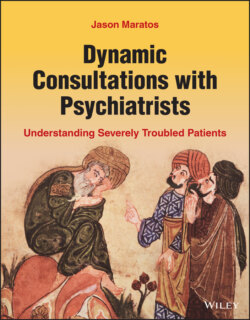Читать книгу Dynamic Consultations with Psychiatrists - Jason Maratos - Страница 79
Consultation
ОглавлениеThis was a comprehensive assessment of a difficult patient. Let me say at first that we are in the field of combining pure psychiatric treatment (with medication) with psychotherapy. I have no doubt, and you gave a convincing history, that this is a person suffering from a bipolar disorder and am surprised that there is not any family history of this.
The problem is that without insight, she has low compliance and low compliance leads to relapse. There are medicines that can help; pharmacology has advanced and this is something that, if you compliance can be assured, a better response can be expected. An important aspect of treatment would be that as Miss C has limited insight about the need for medication for her own welfare, somebody needs to supervise her taking medicines. Somebody in her environment needs to do that; otherwise she experiences a period of euphoria and her self‐confidence increases and it veers toward grandiosity and overconfidence. She then begins to think, “I don't need all that rubbish; doctors do it for their own sake and I am going to stop taking medicines and I am going to spend lots of money to get accessories and clothes and look great.” So that's when somebody else needs to take authority over her and ensure compliance or will need to arrange a prompt psychiatric appointment when they see that she is heading that way.
The other limited comment is about the developmental theory of psychoanalysis. Freud developed the developmental theory based on examining adults who gave a historical recollection of their past. Freud did not systematically examine children growing up.
Developmental psychology has done exactly that and the proposal of oral, anal, phallic, latency, preadolescent, and adolescent genital stages has been seriously challenged (Rutter, 1970, pp. 274–276). Freud's formulation is historical and interesting from a historical point of view of psychoanalysis, but it's not something considered useful by many contemporary psychoanalysts.
The second point is that such a formulation confuses normal development with pathological development. By definition, pathological development does not occur at any stage of normal maturation. So if pathological development is not appropriate, attribute it to an age. For example, Miss C is blaming her family for not serving good food, which is not something that is appropriate (consistently) at any stage of normal development as a pattern. If a 2‐year‐old child is served food they don't like, they will get cross and will try to weave their behavior into a pattern that is often described as representing an oral stage of development, but this is not founded on any scientific basis. So, the easiest thing would be to forget this aspect of the psychoanalytic theory because it is not a useful part of psychoanalysis.
JM pointed out that the doctor was already doing what one can expect to achieve with a patient who is suffering from a bipolar illness. The main foundation of treatment would be medication and the would be ensuring compliance. Without these, any talking aimed at changing feelings and thoughts would be wasted.
Someone who is manic and thinks they are descendants of President Mao cannot be expected to start a dialogue. The emotional conviction is so strong they will think that you don't understand who you are talking to because “I am a descendent of Jesus or I am a descendent of whomever” or “I am as beautiful and gorgeous as Naomi Campbell,”; “you just don't understand.” So the approach that may be most useful in this phase is supportive and supervisory.
When Miss C becomes more receptive, then you can concentrate on building her self‐esteem, building her resilience, and helping her to develop a realistic approach about her potential; she needs to be helped to value and use her “well” phases to build a realistic future for herself. But during her “ill” phases, all that can be done is concentrate on supporting and supervising her, ensuring that she is safe and that her environment understands her condition. Also, when the first signs of a relapse are seen, she should be taken for immediate psychiatric treatment because she may need hospitalization or restoration of medication because the likelihood is that she will not comply. This is the main problem with people who are manic depressive; the moment that they go toward the extreme of emotions, either toward hypomania or toward depression, they drop their medicines. When they are depressed, they think there is no point, and when they are hypomanic, they think they don't need them.
It is at this point, that someone in her life, who is not mentally ill to say: “She is going up or down too much and this is the beginning of something is going on. Let's see a psychiatrist.” The psychiatrist will then institute the appropriate treatment. When Miss C is accessible, then it can be planned how she manages a genuine and serious illness. Miss C has a major risk of suicide. Her previous attempt (carbon monoxide and having left a note!) supports this view.
We have drawn an agreement between her and her mother that she needs to ensure that she takes her medication before 11:30 p.m. and are hopeful that will work.
This is exactly the right thing. And from the doctor's point of view, I think you should not have the expectation of a transformation. This is a serious illness that unfortunately has a guarded prognosis. What I am saying is that you should not be demoralized if she is not cured. Doctors who have high expectations of their patients are carrying the risk of making themselves vulnerable to disappointment and eventual burnout (Maratos, 1996). The issue of burnout among healthcare workers is of enormous significance. I attached references from the extensive bibliography that the reader may find useful (Maslach et al., 2001; Maslach & Leiter, 2016; Pines & Maslach, 1978).
